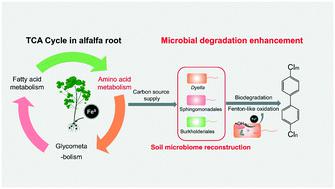当前位置:
X-MOL 学术
›
Environ. Sci.: Nano
›
论文详情
Our official English website, www.x-mol.net, welcomes your
feedback! (Note: you will need to create a separate account there.)
Synergistic remediation of PCB-contaminated soil with nanoparticulate zero-valent iron and alfalfa: targeted changes in the root metabolite-dependent microbial community
Environmental Science: Nano ( IF 5.8 ) Pub Date : 2021-2-22 , DOI: 10.1039/d1en00077b Ting Wu 1, 2, 3, 4 , Yangzhi Liu 1, 2, 3, 4 , Kun Yang 1, 2, 3, 4, 5 , Lizhong Zhu 1, 2, 3, 4, 5 , Jason C. White 6, 7, 8 , Daohui Lin 1, 2, 3, 4, 5
Environmental Science: Nano ( IF 5.8 ) Pub Date : 2021-2-22 , DOI: 10.1039/d1en00077b Ting Wu 1, 2, 3, 4 , Yangzhi Liu 1, 2, 3, 4 , Kun Yang 1, 2, 3, 4, 5 , Lizhong Zhu 1, 2, 3, 4, 5 , Jason C. White 6, 7, 8 , Daohui Lin 1, 2, 3, 4, 5
Affiliation

|
Phytoremediation is a cost-effective and environmentally sustainable remediation technology for many types of contaminants, but has low efficacy and applicability for persistent organic pollutant- (POP-) contaminated soils. Reactive nanoparticulate zero-valent iron (nZVI) can enhance plant growth and synergistically promote the remediation of POP-contaminated soil. Here, we investigated the efficacy and mechanisms by which nZVI (0, 10, 100, and 1000 mg kg−1) and alfalfa (Medicago sativa) synergistically remediate polychlorinated biphenyl- (PCB-) contaminated agricultural soil for 120 days. The results show that the alfalfa remediation efficiencies of PCB28- and PCB180-contaminated soil are significantly elevated from 66.7% and 38.5% to 93.1% and 52.3% with the increase of nZVI from 0 to 1000 mg kg−1, respectively. These values are significantly greater than those of nZVI and phytoremediation strategies alone, and the synergistic effect is induced by the alterations of microecological environment of the alfalfa rhizosphere. Plant root metabolomic analysis and rhizosphere microbial community profiling reveal that nZVI influences amino acid metabolism and this change in metabolites could be an energy source for reshaping the rhizosphere microbial community towards PCB degradation. The capabilities of the microbiota to utilize carbon sources are facilitated in PCB-contaminated soil with nZVI and alfalfa co-treatment. In addition to significant microbial degradation, root exudates are shown to promote the production of hydroxyl radicals in the simulated nZVI-alfalfa system. This work provides a new strategy using nanomaterial-facilitated phytoremediation to promote the restoration of POP-contaminated soils.
中文翻译:

纳米颗粒零价铁和苜蓿协同修复多氯联苯污染的土壤:根代谢物依赖性微生物群落的靶向变化
植物修复是一种对许多类型的污染物都具有成本效益且在环境上可持续的修复技术,但是对于持久性有机污染物(POP)污染的土壤,其有效性和适用性较低。活性纳米零价铁(nZVI)可以促进植物生长,并协同促进POP污染土壤的修复。在这里,我们研究了nZVI(0、10、100和1000 mg kg -1)和苜蓿(紫花苜蓿)的功效和机理。)协同修复受多氯联苯(PCB-)污染的农业土壤120天。结果表明,随着nZVI从0到1000 mg kg -1的增加,被PCB28和PCB180污染的土壤的苜蓿修复效率从66.7%和38.5%显着提高到93.1%和52.3%。, 分别。这些值明显大于单独的nZVI和植物修复策略的值,并且协同作用是由苜蓿根际微生态环境的变化引起的。植物根部代谢组学分析和根际微生物群落分析表明,nZVI影响氨基酸代谢,这种代谢产物的变化可能是重塑根际微生物群落朝PCB降解的能源。通过nZVI和苜蓿共处理,可在PCB污染土壤中提高微生物群利用碳源的能力。除了显着的微生物降解作用外,在模拟的nZVI-苜蓿系统中,根系分泌物还可以促进羟基自由基的产生。
更新日期:2021-03-04
中文翻译:

纳米颗粒零价铁和苜蓿协同修复多氯联苯污染的土壤:根代谢物依赖性微生物群落的靶向变化
植物修复是一种对许多类型的污染物都具有成本效益且在环境上可持续的修复技术,但是对于持久性有机污染物(POP)污染的土壤,其有效性和适用性较低。活性纳米零价铁(nZVI)可以促进植物生长,并协同促进POP污染土壤的修复。在这里,我们研究了nZVI(0、10、100和1000 mg kg -1)和苜蓿(紫花苜蓿)的功效和机理。)协同修复受多氯联苯(PCB-)污染的农业土壤120天。结果表明,随着nZVI从0到1000 mg kg -1的增加,被PCB28和PCB180污染的土壤的苜蓿修复效率从66.7%和38.5%显着提高到93.1%和52.3%。, 分别。这些值明显大于单独的nZVI和植物修复策略的值,并且协同作用是由苜蓿根际微生态环境的变化引起的。植物根部代谢组学分析和根际微生物群落分析表明,nZVI影响氨基酸代谢,这种代谢产物的变化可能是重塑根际微生物群落朝PCB降解的能源。通过nZVI和苜蓿共处理,可在PCB污染土壤中提高微生物群利用碳源的能力。除了显着的微生物降解作用外,在模拟的nZVI-苜蓿系统中,根系分泌物还可以促进羟基自由基的产生。











































 京公网安备 11010802027423号
京公网安备 11010802027423号